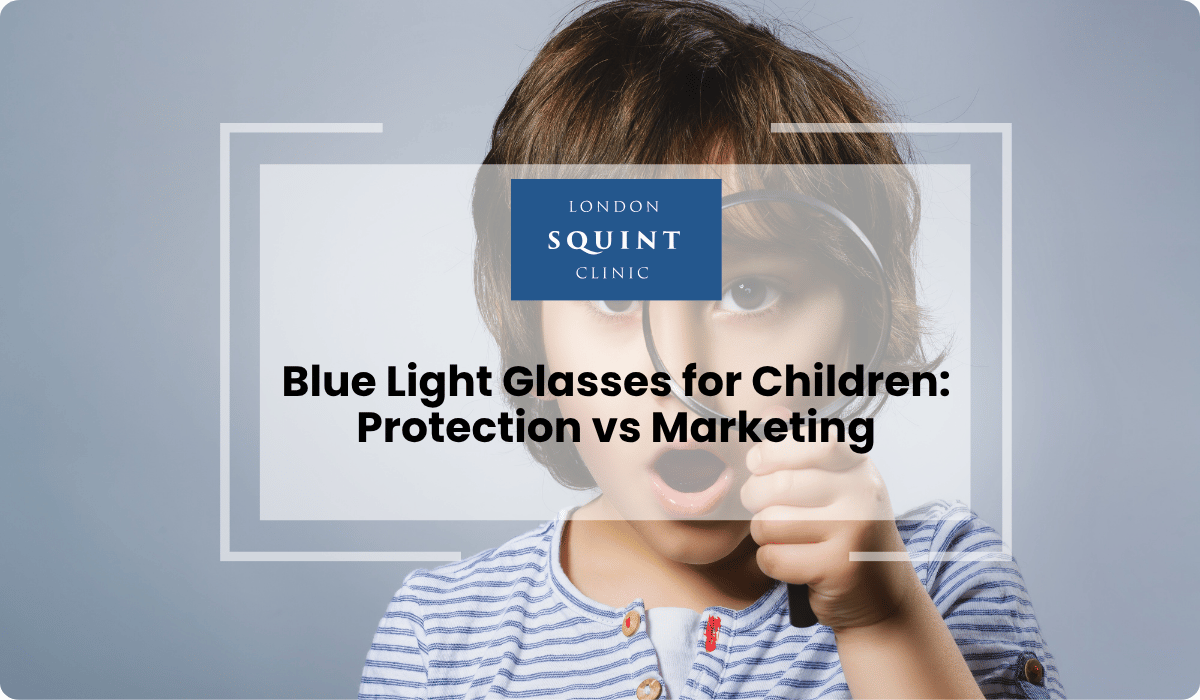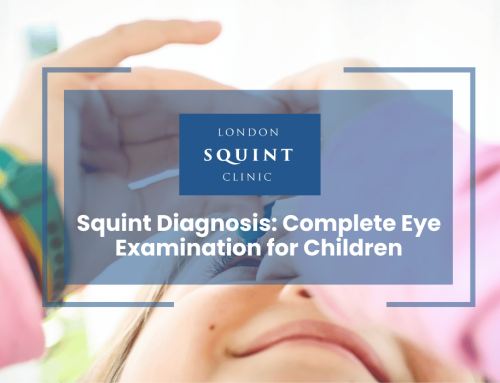Blue Light Glasses for Children: Protection vs Marketing
Essential Insights for Parents: Blue Light Glasses and Children’s Eye Health
Evidence vs. Marketing: Major ophthalmological organizations do not currently recommend blue light glasses as essential protection for children’s eye health, despite marketing claims suggesting otherwise.
Focus on Habits: The 20-20-20 rule (looking at something 20 feet away for 20 seconds every 20 minutes), proper device positioning, and regular breaks are more evidence-based approaches to preventing digital eye strain.
Selective Benefits: Blue light glasses may be beneficial in specific scenarios, such as for children with diagnosed photosensitivity conditions or as part of a comprehensive approach to improving sleep when evening screen use cannot be avoided.
Balanced Activities: Regular outdoor play and diverse non-digital activities provide natural protection against many digital vision concerns while supporting overall visual development.
Professional Guidance: Decisions about blue light protection should be made in consultation with qualified eye care professionals based on individual children’s needs rather than as a universal preventative measure.
Table of Contents
- What Are Blue Light Glasses and How Do They Work?
- Understanding Digital Eye Strain in Children
- Do Children Actually Need Blue Light Glasses?
- Scientific Evidence: Blue Light Impact on Developing Eyes
- Separating Marketing Claims from Medical Facts
- Practical Alternatives to Blue Light Glasses for Kids
- When Blue Light Protection Might Be Beneficial
- Creating Healthy Digital Habits for Children’s Eye Health
What Are Blue Light Glasses and How Do They Work?
Blue light glasses, also known as blue light blocking glasses, are eyewear designed with specialised lenses that claim to filter out blue light wavelengths emitted by digital screens. These wavelengths fall within the 415-455 nanometer range on the visible light spectrum and are characterised by their short, high-energy properties. The glasses typically feature lenses with a slight yellow tint, though many modern versions appear nearly clear to the naked eye.
The fundamental mechanism behind blue light glasses involves selective filtering. The lenses contain specific compounds or coatings designed to block or absorb blue light wavelengths while allowing other light to pass through unimpeded. Manufacturers claim this selective blocking helps reduce potential eye strain and protect the retina from what some suggest might be harmful exposure, particularly during extended screen time.
For children’s versions of blue light glasses, the frames are typically designed to be more durable, flexible, and sized appropriately for smaller faces. Many feature adjustable nose pads and temple arms to accommodate growth. The marketing for children’s blue light protection often emphasises both potential eye health benefits and improved sleep patterns, suggesting that reducing blue light exposure, especially in the evening, might help maintain natural circadian rhythms.
Understanding Digital Eye Strain in Children
Digital eye strain, sometimes called computer vision syndrome, manifests differently in children compared to adults. Children may not readily identify or articulate their discomfort, instead displaying behavioural changes such as eye rubbing, increased blinking, headaches, or avoidance of screen-based activities. The developing visual system in children is particularly susceptible to strain as their eye structures and visual processing pathways are still maturing.
The primary contributors to digital eye strain in children include prolonged focusing at fixed distances, reduced blink rate during screen use, improper viewing angles, and poor lighting conditions. Unlike adults, children often hold devices closer to their eyes and may use them in suboptimal positions, potentially exacerbating strain. Additionally, children may be less likely to take visual breaks during extended screen sessions.
Symptoms of digital eye strain in the paediatric population commonly include:
- Headaches, particularly frontal or around the eyes
- Blurred vision after screen use
- Dry or irritated eyes
- Difficulty shifting focus between near and far objects
- Increased sensitivity to light
- Neck and shoulder discomfort from poor posture
It’s important to note that while these symptoms are typically temporary, recurring strain could potentially impact visual development in children whose visual systems are still developing. Regular comprehensive eye examinations are essential for children with significant screen exposure to monitor visual development and identify any emerging issues.
Do Children Actually Need Blue Light Glasses?
The question of whether children genuinely need blue light glasses requires careful consideration of both the available evidence and individual circumstances. Currently, major ophthalmological organisations, including the Royal College of Ophthalmologists and the American Academy of Ophthalmology, have not endorsed blue light glasses as a necessary protective measure for children. This position stems from the limited clinical evidence demonstrating significant harmful effects of blue light from screens on eye health.
For most children with healthy eyes and normal visual development, blue light glasses are unlikely to provide substantial benefits for eye health protection. The natural crystalline lens in children’s eyes already provides some filtering of blue light, and the intensity of blue light from digital devices is significantly lower than that from natural sunlight. When considering glasses for children, addressing actual refractive errors or visual needs should take priority over blue light concerns.
However, individual factors may influence the potential utility of blue light glasses for specific children. Those with certain photosensitivity conditions, children who experience consistent discomfort during screen use despite proper ergonomics, or those with disrupted sleep patterns potentially linked to evening screen exposure might experience subjective benefits. Additionally, children who spend exceptionally long periods on digital devices might be candidates for consideration, though addressing screen time limits would be equally important.
The decision should ultimately be made in consultation with a qualified paediatric ophthalmologist or optometrist who can assess the child’s specific visual needs, screen habits, and any presenting symptoms rather than as a preventative measure for all children.
Scientific Evidence: Blue Light Impact on Developing Eyes
The scientific literature regarding blue light’s impact on developing eyes presents a nuanced picture that differs significantly from many marketing claims. Laboratory studies have demonstrated that extreme exposure to blue light can cause retinal damage in experimental conditions. However, these studies typically involve light intensities and exposure durations far exceeding what children would experience during normal device use. The blue light emitted by digital screens is of considerably lower intensity than natural daylight, which contains abundant blue wavelengths.
Research specifically examining blue light from digital devices and its effects on children’s eye development remains limited. The few controlled studies conducted have not established a causal relationship between typical screen blue light exposure and structural damage to developing eyes. The human eye, including the developing eye, has natural protective mechanisms against moderate blue light exposure, including filtering by the cornea and lens, as well as blinking and pupillary responses.
Regarding visual development, current evidence does not suggest that blue light from screens directly impairs normal developmental processes in children with healthy eyes. The more significant concern from a developmental perspective appears to be related to potential refractive errors from prolonged near work rather than specifically from blue light exposure. Some studies have indicated that insufficient outdoor time (with natural light exposure) may be a more significant factor in myopia development than screen time itself.
While research continues in this area, the current scientific consensus among major ophthalmological bodies does not support the necessity of blue light filtering for eye health protection in most children. The evidence base is stronger for blue light’s potential impact on circadian rhythms and sleep, which represents a separate consideration from structural eye health.
Separating Marketing Claims from Medical Facts
The marketing of blue light glasses for children often employs compelling narratives that can be difficult to distinguish from evidence-based medical recommendations. Common marketing claims include assertions that these glasses will “protect developing retinas,” “prevent digital eye damage,” or “shield against harmful rays.” These statements frequently overstate both the potential risks of blue light and the protective benefits of the glasses, creating unnecessary parental anxiety about normal screen use.
From a medical perspective, several key facts should be considered when evaluating these claims. First, no major ophthalmological organisation currently recommends blue light glasses as essential protection for children’s eye health. Second, digital screens emit significantly less blue light than natural daylight, which children have been exposed to throughout human evolution. Third, while digital eye strain is real, it is primarily related to factors such as reduced blinking, fixed focus distance, and extended use rather than specifically to blue light exposure.
Parents should be particularly cautious about marketing that uses scientific-sounding terminology without proper context. Terms like “high-energy visible light damage” or references to isolated laboratory studies may sound authoritative but often fail to represent the full scientific understanding or real-world conditions. Similarly, testimonials and reviews, while potentially reflecting genuine subjective experiences, do not constitute scientific evidence of efficacy.
When evaluating blue light glasses for children, consider consulting independent sources such as paediatric ophthalmologists, optometrists, or evidence-based medical organisations rather than relying solely on manufacturer claims. This approach helps ensure decisions are based on children’s actual visual needs rather than marketing-induced concerns.
Practical Alternatives to Blue Light Glasses for Kids
Rather than investing in blue light glasses with limited evidence supporting their necessity, parents can implement several evidence-based strategies to protect children’s visual comfort and eye health during digital device use. These practical alternatives address the underlying causes of digital eye strain more directly and support overall visual development.
The 20-20-20 rule represents one of the most effective approaches: encourage children to look at something 20 feet away for 20 seconds every 20 minutes of screen time. This simple practice helps reduce accommodative strain and increases blinking frequency. Proper positioning of devices is equally important—screens should be positioned slightly below eye level at an arm’s length distance, with appropriate font sizes to prevent unnecessary leaning or squinting.
Environmental modifications can significantly impact visual comfort. Ensure adequate room lighting to reduce screen contrast, position screens to minimise glare from windows or overhead lights, and consider using matte screen protectors to reduce reflections. Many devices also offer built-in blue light reduction settings or “night mode” options that can be scheduled to activate in evening hours without requiring additional eyewear.
Perhaps most importantly, balanced daily activities support overall eye health. Encourage regular outdoor play, as natural light exposure has been associated with reduced myopia progression in children. Maintain appropriate screen time limits according to age, and schedule regular comprehensive eye examinations to monitor visual development and identify any emerging issues requiring intervention.
These evidence-based approaches address the multifactorial nature of digital eye strain more comprehensively than blue light glasses alone and promote healthy visual habits that benefit children’s overall development.
When Blue Light Protection Might Be Beneficial
While blue light glasses aren’t universally necessary for children, certain specific scenarios exist where they might offer meaningful benefits. Children with diagnosed photosensitivity conditions or those with certain retinal disorders may experience greater comfort with selective blue light filtering. In these cases, the glasses should be prescribed by a paediatric ophthalmologist as part of a comprehensive treatment approach rather than purchased as an over-the-counter solution.
Evening use represents another potential application where evidence is somewhat stronger. Research has demonstrated that blue light exposure in the hours before bedtime can suppress melatonin production and potentially disrupt sleep patterns. For children who use digital devices in the evening and demonstrate consistent sleep difficulties, blue light glasses specifically during these hours might be considered as one component of improved sleep hygiene. However, reducing or eliminating screen time before bed remains the preferred approach.
Children who experience persistent symptoms of digital eye strain despite implementing proper ergonomics, taking regular breaks, and maintaining appropriate viewing distances might benefit from trying blue light glasses to determine if they provide subjective relief. This approach should be viewed as experimental rather than preventative, with careful monitoring of whether symptoms actually improve with their use.
Finally, children who require prescription glasses for refractive errors may benefit from adding blue light filtering as an optional lens feature, particularly if they spend significant time on digital devices. This integrated approach addresses their primary visual needs while potentially providing additional comfort, though parents should understand that the blue light filtering represents a supplementary rather than essential feature.
Creating Healthy Digital Habits for Children’s Eye Health
Establishing healthy digital habits during childhood creates a foundation for lifelong visual health that extends far beyond the question of blue light exposure. Age-appropriate screen time limits represent the cornerstone of this approach. The Royal College of Paediatrics and Child Health recommends negotiating clear boundaries based on individual family needs rather than strict time limits, while ensuring that screen use doesn’t displace essential activities like sleep, physical activity, and face-to-face interaction.
Ergonomic awareness should be introduced early and reinforced consistently. Teach children to maintain proper posture with devices at appropriate heights and distances, and consider child-sized furniture that supports correct positioning. For younger children, larger screens viewed from appropriate distances are generally preferable to small handheld devices held close to the face, which may encourage excessive accommodation and convergence.
Balanced daily activities provide natural protection against many digital vision concerns. Regular outdoor play not only reduces screen time but also exposes children to beneficial natural light patterns and encourages focusing at varied distances. Engaging in arts, crafts, reading physical books, and other non-digital activities helps develop diverse visual skills and reduces overall screen exposure.
Parental modelling significantly influences children’s digital habits. When adults demonstrate healthy boundaries with their own devices, regular screen breaks, and proper ergonomics, children naturally adopt similar patterns. Creating device-free times and zones within the home, such as during meals or in bedrooms, helps establish healthy boundaries for the entire family.
Finally, regular comprehensive eye examinations with a paediatric specialist remain essential for monitoring visual development, regardless of digital habits. These assessments can identify emerging issues before they impact learning or development and provide opportunities for personalised guidance on digital device use based on each child’s specific visual needs.
Frequently Asked Questions
Are blue light glasses actually necessary for children?
Blue light glasses are not considered necessary for most children according to major ophthalmological organizations. The natural lens in children’s eyes already provides some blue light filtering, and digital screens emit significantly less blue light than natural sunlight. For most children with healthy eyes, implementing proper screen habits and ergonomics is more beneficial than blue light glasses.
Can blue light from screens damage my child’s eyes?
Current scientific evidence does not support claims that blue light from typical screen use damages children’s eyes. While laboratory studies show intense blue light can cause retinal damage, the amount emitted by digital devices is considerably lower than these experimental conditions and natural daylight. Digital eye strain is real but primarily related to factors like reduced blinking and fixed focus distance rather than blue light specifically.
How can I tell if my child has digital eye strain?
Signs of digital eye strain in children include frequent eye rubbing, increased blinking, headaches, blurred vision after screen use, dry or irritated eyes, difficulty shifting focus between near and far objects, light sensitivity, and neck/shoulder discomfort. Children may not articulate these symptoms clearly but might show behavioral changes like avoiding screen activities or becoming unusually irritable during device use.
What’s the best way to protect my child’s eyes during screen time?
The best protection includes implementing the 20-20-20 rule (looking at something 20 feet away for 20 seconds every 20 minutes), positioning screens slightly below eye level at arm’s length, ensuring adequate room lighting, reducing glare, setting appropriate screen time limits, encouraging regular outdoor play, and scheduling comprehensive eye examinations. These practices address the multiple factors contributing to digital eye strain more effectively than blue light glasses alone.
Could blue light glasses help my child sleep better?
Blue light glasses worn in the evening hours might help some children who use screens before bedtime, as blue light can suppress melatonin production and potentially disrupt sleep patterns. However, reducing or eliminating screen time 1-2 hours before bed is the more effective approach for improving sleep. If screens must be used in the evening, built-in device night modes can provide similar benefits without additional eyewear.
At what age is it safe for children to start wearing blue light glasses?
There’s no specific age restriction for blue light glasses, as they don’t typically contain prescription lenses. However, since they’re generally unnecessary for most children’s eye health, the question of appropriate age is less relevant than whether they’re needed at all. If considering them for specific circumstances, ensure they’re properly fitted to the child’s face to prevent discomfort or improper wear, regardless of age.
Should children with prescription glasses add blue light filtering?
Children who already require prescription glasses for refractive errors might consider adding blue light filtering as an optional lens feature, particularly if they spend significant time on digital devices. This integrated approach addresses their primary visual needs while potentially providing additional comfort during screen use. Discuss this option with your child’s eye care professional to determine if it’s appropriate for their specific situation.
Find out if you are suitable for Double Vision Treatment
Not everyone is eligible for double vision surgery.
Find out if you could benefit from this life-changing surgery by taking the quick self-suitability quiz below:
Our most popular procedures

Hello, I’m Nadeem Ali
I’m one of the few eye surgeons in the world with 100% focus on Squint and Double Vision Surgery.
I have 24 years of eye surgery experience, and worked for 13 years as a Consultant at London’s renowned Moorfields Eye Hospital.
In 2023, I left the NHS to focus fully on treating patients from across the world at the London Squint Clinic. You can read more about me here.
There’s lots of information on the website about: squint surgery, double vision surgery and our pricing.
The most rewarding part of my job is hearing patients tell me how squint or double vision surgery has changed their lives. You can hear these stories here.
Mr Nadeem Ali
MA MB BChir MRCOphth FRCSEd(Ophth)





